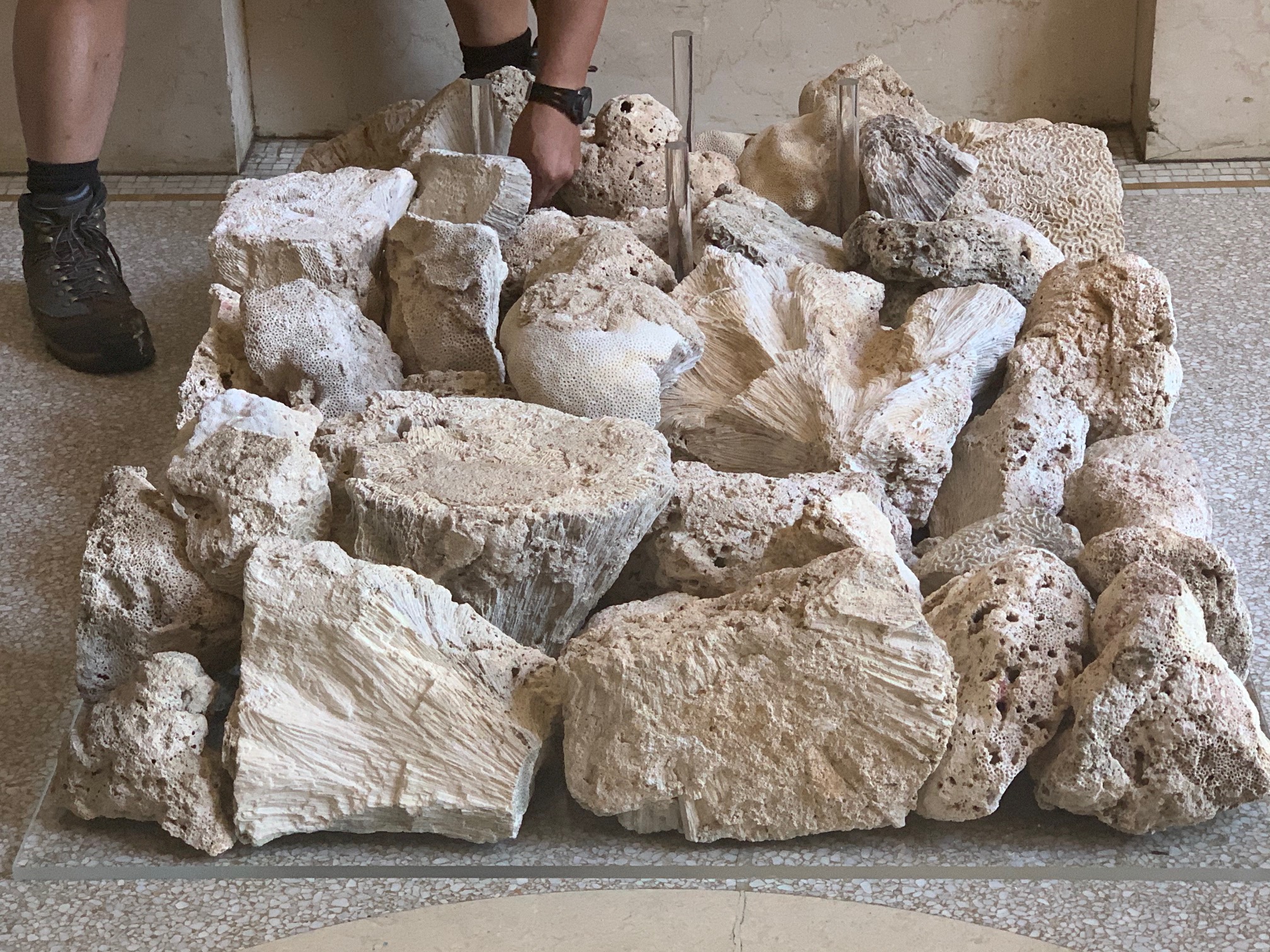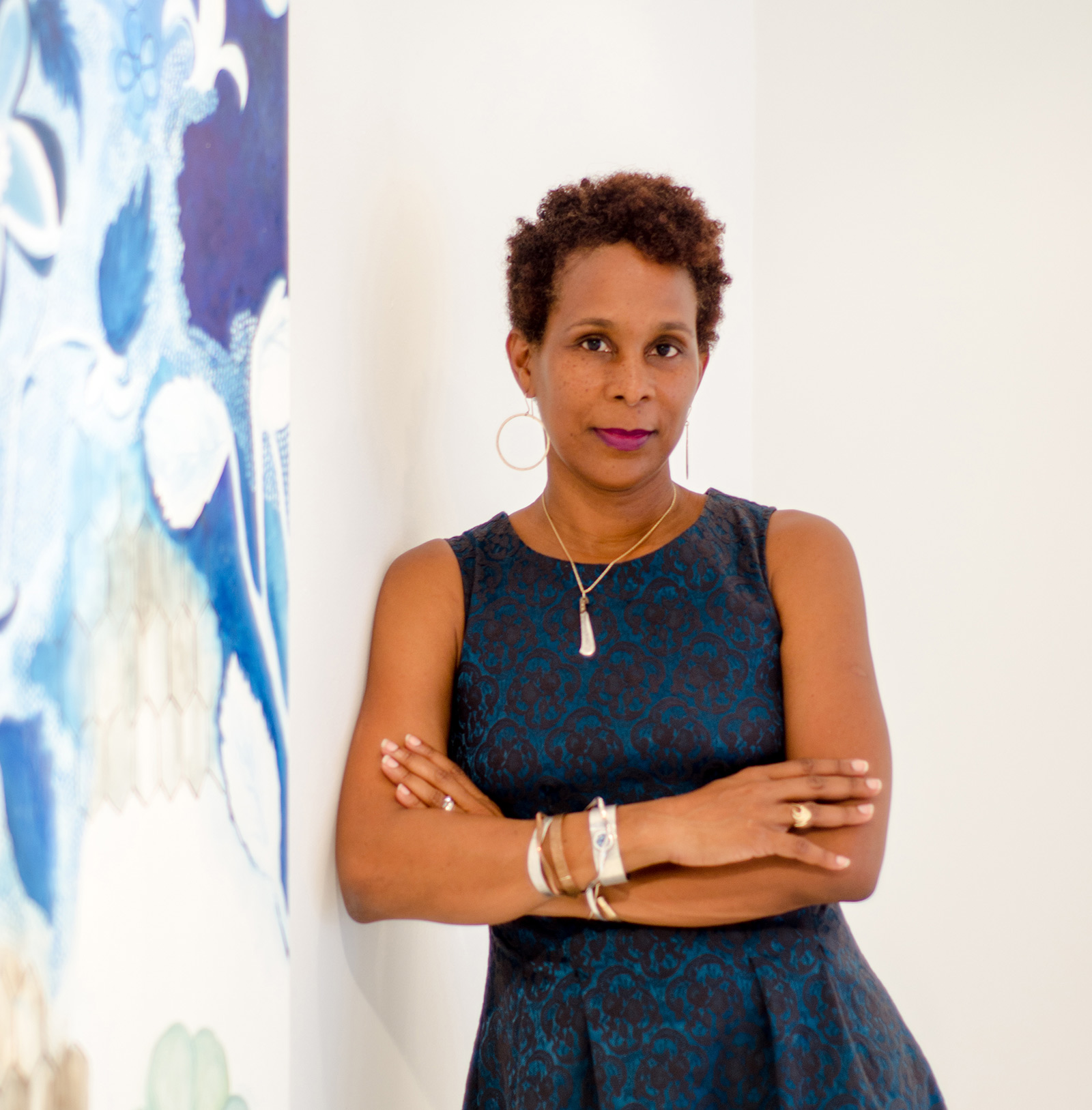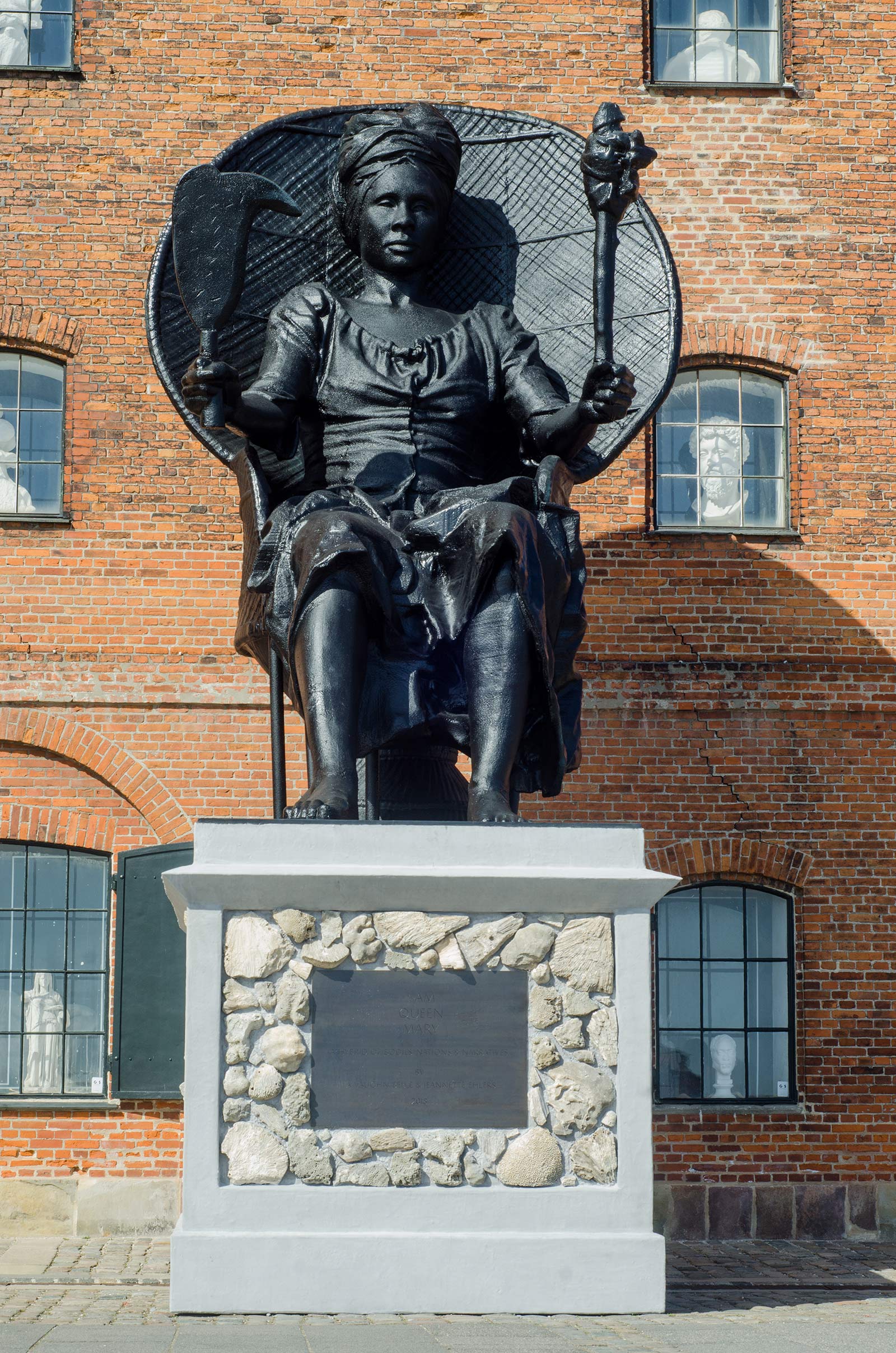There is now something public, very visual, and quite colossal that serves as a reminder of our contribution, and I Am Queen Mary will continue to generate dialogue around this history.
[Photos: David Berg]
When the 23-foot monument I Am Queen Mary made her March 2018 debut in front of the West Indian Warehouse in Copenhagen, Denmark, its commemoration of the 100th anniversary of the sale and transfer of the Danish West Indies (now the U.S. Virgin Islands) made international headlines. The historical significance of its debut was literally embedded into I Am Queen Mary’s foundation: the plinth was formed by 1.5 tons of coral stones, imported from St. Croix in the Virgin Islands, where the stones were originally cut by enslaved Africans who were sent into the ocean to harvest them.
To continue important conversations about the artwork’s genesis, Barnard College proudly welcomed a scaled-down version of the sculpture to campus on October 15, 2019. I Am Queen Mary, a monumental symbol that celebrates and centers the story of people who resisted Danish colonialism in the Caribbean, is a transnational collaboration between U.S. Virgin Islands’ multidisciplinary artist La Vaughn Belle and Copenhagen-based performance artist Jeannette Ehlers.
On long-term loan to the College, the statue comes to Barnard courtesy of Belle, Ehlers, Lisa Kim ’96, and the Ford Foundation, which first commissioned and displayed the piece as part of its summer 2019 Radical Love exhibition at the Ford Foundation Gallery, where Kim is director. I Am Queen Mary will be on view in Barnard Hall and open to the public.
“Centering this artwork and all that it means at the heart of the College is a tremendous teaching and learning opportunity for the Barnard community, our Columbia University and Morningside/Harlem neighbors, as well as the city generally,” said Monica L. Miller, associate professor of English and Africana studies.
A commanding figure that incorporates a multitude of bodies, nations, and narratives, I Am Queen Mary, with its seated stance of resistance, encourages dialogue about how black women hold space and who gets to tell the story. To celebrate the collaboration and its arrival at Barnard, the College spoke with both Belle and Ehlers for this special “Break This Down” interview on I Am Queen Mary.
What was the historical inspiration behind I Am Queen Mary, and what does she represent?
 Jeannette Ehlers: The historical inspiration behind the sculpture is the legacy of Mary Thomas, aka Queen Mary, one of the four female leaders of the 1878 Fireburn labor revolt in Frederiksted, St. Croix. She and the other three “queens” were imprisoned in Copenhagen for their deeds. With this sculpture, we wanted to pay tribute to the act of revolt against the oppressive colonial system, then as well as now. Furthermore, we wanted to highlight and honor her powerful legacy in order to contest the Scandinavian colonial amnesia. On top of that, the sculpture speaks to several civil rights movements, [including] the Black Panther Party and Black Lives Matter. The sculpture also challenges the domination of sculptures in public space in Denmark (and globally) that represent white males.
Jeannette Ehlers: The historical inspiration behind the sculpture is the legacy of Mary Thomas, aka Queen Mary, one of the four female leaders of the 1878 Fireburn labor revolt in Frederiksted, St. Croix. She and the other three “queens” were imprisoned in Copenhagen for their deeds. With this sculpture, we wanted to pay tribute to the act of revolt against the oppressive colonial system, then as well as now. Furthermore, we wanted to highlight and honor her powerful legacy in order to contest the Scandinavian colonial amnesia. On top of that, the sculpture speaks to several civil rights movements, [including] the Black Panther Party and Black Lives Matter. The sculpture also challenges the domination of sculptures in public space in Denmark (and globally) that represent white males.
La Vaughn Belle: The project comes out of a desire to commemorate [the centennial anniversary of the sale and transfer of the former Danish West Indies to the United States] but to do it in a way that would break the wall of the Danish amnesia to their colonial engagements in the Caribbean and to also honor those who survived and fought against their imperial rule. Mary Thomas is a historical figure who emerges as one of the most popular leaders of the Fireburn, the largest labor revolt in Danish colonial history. In the popular memory of the Virgin Islands, she, along with three other women, are celebrated as the “Queens of the Fireburn.” They, among several others, protested the oppressive living and working conditions of the sugar plantations by burning down most of the town of Frederiksted and several other plantations across the island. Their revolt [eventually] led to improvements in working conditions and wages, and ushered in the beginning of labor unions, which came shortly after this period. The other major historical component of the piece are the coral stones that form the base of the work. Gathered from colonial-era buildings, these stones were originally harvested from the ocean by enslaved Africans. Honoring their labor and their foundational role in these societies is a significant source of inspiration for the project.

What did it mean to have the first collaborative sculpture that addressed Denmark’s colonial impact in the Caribbean unveiled in Copenhagen during the 100th anniversary of Denmark’s sale of the Virgin Islands to the United States?
Belle: When I first went to Denmark, in 2008, I was surprised that their landscape had not been marked in the way that ours was. In the Virgin Islands, our towns are named after Danish monarchs, our street names are in Danish, there are remnants of sugar mills and other plantation structures all over the islands. In Denmark, there was very little [about the Virgin Islands], or what exists is hidden; many Danes I encountered had little to no knowledge of their colonial legacies in the Caribbean. I was shocked by that. I was hurt by that. How could they forget 250-plus years of colonization that included trading and enslaving people? What this sculpture [means] for me is that no one else from the Virgin Islands will feel that particular slight of being forgotten if they visit Copenhagen. There is now something public, very visual, and quite colossal that serves as a reminder of our contribution, and I Am Queen Mary will continue to generate dialogue around this history.
Ehlers: In relation to the Centennial of Transfer Day in 2017, there had been quite a lot of focus in Denmark on the Danish colonial past. A national consciousness of our colonial history slowly began to arise, but it was and still is only the beginning of a long process. Due to technical obstacles, we weren’t able to erect the sculpture in 2017, so I Am Queen Mary was first unveiled on March 31, 2018, exactly a year after the Centennial. In the beginning, we were concerned about not getting to do it in the year of the Centennial but quickly learned that it was better it was erected in 2018, since this avoided it only being linked to a conversation around Transfer Day and the Centennial. I Am Queen Mary speaks to the past but most definitely also to the present and the future, and there’s a huge need for these types of dialogues in the world of today.
How did the Danes react to I Am Queen Mary’s towering black presence?
Ehlers: The sculpture has received a lot of attention, nationally as well as internationally. It has been extremely well received in Copenhagen. Tons of people pass by it every day, as it is located on a highly trafficked way, for tourists and for locals, and almost everyone stops to check out who this huge black woman is. They get to know not only of Queen Mary’s legacy but also about Denmark’s colonial past, which is crucial for understanding the present. On top of that, with the sculpture we have created a space where black and brown people can see themselves represented in an empowering way! We get emails from people living in Copenhagen expressing their gratitude about the piece and also from people outside the country who tell us they only visit Copenhagen because of it. All of this positive feedback is amazing to us, and it is as if the sculpture really belongs to the city now. “She” has definitely claimed her space. However, there are also critical voices who do not fancy the sculpture nor what it stands for. But that’s part of the game, and we were of course prepared for that.
Belle: It’s true the work in Copenhagen is colossal, and it’s one of the things people are most impacted by. At seven meters, the equivalent of two stories, its size is intentionally matching the height of Michelangelo’s David, [which is] on the other side of the Danish West Indian Warehouse. It’s also in conversation with the sculptures of Danish kings throughout the city [that are] of equal stature. In terms of the reaction, I would say for some, there is confusion and curiosity. For others, there is gratitude for a powerful alternative voice in the public landscape. And for others still, I would imagine there is displeasure for that same reason. I Am Queen Mary is a disruption in their public space, but more importantly it’s a disruption in their national ethos that has tended toward erasure of their colonial engagement with Ghana and other African descendants they traded and colonized in the Caribbean.
Why was it important to bring the statue to Barnard, and what do you want students to learn about public art?
Belle: Rather than just memorialize the past, public art can forge new relationships to power and place. As someone who went to Columbia College and lived on Barnard’s campus, this is an impactful alignment. Barnard is perfectly positioned to engage with this sculpture in really meaningful and nuanced ways. One thing that public art and institutions have in common is that they both generate dialogue. They have the power to produce new publics by generating new dialogues and collective experiences. They both shape ideas about value, what knowledge should be learned, and whose stories matter.
Ehlers: Apart from Barnard College having a strong connection to both La Vaughn and Lisa Kim, I think Barnard College is a perfect place to bring I Am Queen Mary, since it is an all-women college, nurturing female power and wit. And that is what I Am Queen Mary stands for. Secondly, I think art is a great way to create knowledge production, which in this case might open up new dimensions and alternative learning processes to the students. I Am Queen Mary passes on complex narratives about coloniality, resistance, and empowerment, historically, as well as in the now, through a bodily perception and experience.
How significant is it that I Am Queen Mary will reside in the same building where Malcolm X gave his last public speech before his assassination?
Ehlers: It gives me goose bumps to think about the relation between I Am Queen Mary and Malcolm X “in the same space.” The spirituality in this connection is overwhelming. It definitely speaks to a common struggle and strong connectivity within the African diaspora and across time and space. On the other hand, it reminds us that these issues are still very urgent and relevant today, which is sad but true.
Belle: The sculpture is an allegorical work that creates a space for intersections with various diasporic narratives of resistance. The end of Malcolm X’s life was marked by the transformation from being an American civil rights figure into an international one, in which his emerging politics of African diasporic unity became prominent. Our work brings a rebel queen from the Caribbean into conversation with, of course, the iconic photograph of Huey P. Newton of the Black Panthers but acts as a bridge to connect this history with other stories of resistance. The title I Am Queen Mary was conceived as a form of reenactment of these histories and a way to situate the viewer. It connects to the 1968 sanitation workers’ strike in which the placard “I Am a Man” was displayed. It connects to the Cuban slogan “Seremos como el Che” [“We will be like Che”]. And it also connects to the end scene of the Spike Lee movie where children announce “I am Malcolm X.” So we are thrilled that I Am Queen Mary is here and that the symbolic connections are now made more physical.
View the slideshow of the installation of the I Am Queen Mary figure below:
Barnard experts explain.



